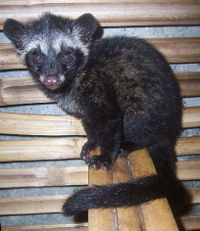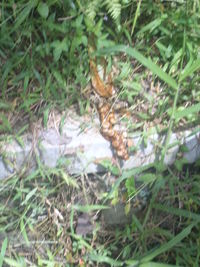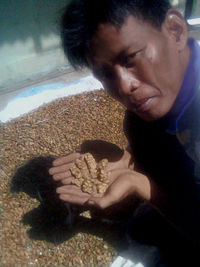Kopi Luwak
Kopi luwak (Indonesian [ˈkopi ˈlu.ak]), or civet coffee, is coffee made from the beans of coffee berries which have been eaten by the Asian Palm Civet (Paradoxurus hermaphroditus) and other related civets, then passed through its digestive tract.[1] A civet eats the berries for their fleshy pulp. In its stomach, proteolytic enzymes seep into the beans, making shorter peptides and more free amino acids. Passing through a civet's intestines the beans are then defecated, keeping their shape. After gathering, thorough washing, sun drying, light roasting and brewing, these beans yield an aromatic coffee with much less bitterness, widely noted as the most expensive coffee in the world.
Kopi luwak is produced mainly on the islands of Sumatra, Java, Bali and Sulawesi in the Indonesian Archipelago, and also in the Philippines (where the product is called motit coffee in the Cordillera and kape alamid in Tagalog areas) and also in East Timor (where it is called kafé-laku). Weasel coffee is a loose English translation of its name cà phê Chồn in Vietnam, where popular, chemically simulated versions are also produced.
Contents |
Background

Kopi is the Indonesian word for coffee. Luwak is a local name of the Asian palm civet in Sumatra and Johor, Malaysia. Palm civets are primarily frugivorous, feeding on berries and pulpy fruits such as from fig trees and palms. Civets also eat small vertebrates, insects, ripe fruits and seeds.[2].
Production
Early production began when beans were gathered in the wild from where a civet would defecate as a means to mark its territory. On farms, civets are either caged or allowed to roam within defined boundaries.[1]
Coffee cherries are eaten by a civet for their fruit pulp. After spending about a day and a half in the civet's digestive tract[3] the beans are then defecated in clumps, having kept their shape and still covered with some of the fleshy berry's inner layers. They are gathered, thoroughly washed, sun dried and given only a light roast so as to keep the many intertwined flavors and lack of bitterness yielded inside the civet.
Cultivars, blends, and tastes
Kopi luwak is a name for many specific cultivars and blends of arabica, robusta, liberica, excelsa or other beans eaten by civets, hence the taste can vary greatly. Nonetheless, kopi luwak coffees have a shared aroma profile and flavor characteristics, along with their lack of bitterness. Coffee critic Chris Rubin has said, "The aroma is rich and strong, and the coffee is incredibly full bodied, almost syrupy. It’s thick with a hint of chocolate, and lingers on the tongue with a long, clean aftertaste."[3]
Kopi luwak tastes unlike heavy roasted coffees, since roasting levels range only from cinnamon color to medium, with little or no caramelization of sugars within the beans as happens with heavy roasting. Moreover, kopi luwaks which have very smooth profiles are most often given a lighter roast. Iced kopi luwak brews may bring out some flavors not found in other coffees.
Sumatra is the world's largest regional producer of kopi lowak. Sumatran civet coffee beans are mostly an early arabica variety cultivated in the Indonesian archipelago since the seventeenth century. Tagalog cafe alamid (or alamid cafe) comes from civets fed on a mixture of coffee beans and is sold in the Batangas region along with gift shops near airports in the Philippines.
Research

Research by food scientist Massimo Marcone at the University of Guelph in Ontario, Canada showed that the civet's endogenous digestive secretions seep into the beans. These secretions carry proteolytic enzymes which break down the beans' proteins, yielding shorter peptides and more free amino acids. Since the flavor of coffee owes much to its proteins, there is a hypothesis that this shift in the numbers and kinds of proteins in beans after being swallowed by civets brings forth their unique flavor. The proteins are also involved in non-enzymatic Maillard browning reactions brought about later by roasting. Moreover, while inside a civet the beans begin to germinate by malting which also lowers their bitterness.[4][5][3]
Safety
At the outset of his research Marcone doubted the safety of kopi luwak. However, he found that after the thorough washing, levels of harmful organisms were insignificant. Roasting at high temperature has been cited as making the beans safer after washing.[3]
Economics
Kopi luwak is the most expensive coffee in the world, selling for between US $100 and $600 per pound.[1] It is sold by weight mainly in Japan and the United States and served in Southeast Asian coffeehouses by the cup. Sources vary widely as to annual worldwide production.[6]
Sales by the cup
In November 2006 Herveys Range Heritage Tea Rooms, a small cafe in the hills outside Townsville in Queensland, Australia, put kopi luwak coffee on its menu at AUD50.00 (US $46.00) a cup, selling about seven cups a week, which gained nationwide Australian and international press.[7] In April 2008 the brasserie at Peter Jones department store in London's Sloane Square began selling a blend of kopi luwak and Blue Mountain called Caffe Raro for £50 (US $79.00) a cup.[8]
Civet coffee imitation
Civet coffee imitation is an attempt to imitate the taste of kopi luwak. It is a response to the decrease in civet population, caused by hunting for meat.[9] Kopi luwak production involves a great deal of labor, whether farmed or wild-gathered. The small production quantity and the labor involved in production contribute to the coffee's high cost.[10] The high price of kopi luwak is another factor that drives the search for a way to produce kopi luwak in large quantities, lowering the cost.
The current method to recreate the taste of kopi luwak is by blending different types of coffees, such as Coffea arabica and Coffea robusta, with chocolate, vanilla, caramel, and other components.
A Vietnamese chemically processed imitation is marketed using the name "Weasel Coffee" for a much lower price than real civet coffee.
A study done by the University of Guelph examined the process in which the animal's stomach acids and enzymes digest the beans' covering and ferment the beans themselves.[11] The University of Florida has also analyzed the chemical components in kopi luwak.[12][13][14]
Kopi muncak
Kopi muncak (or kopi muntjak) is made from the dung of barking deer (muntjac) found throughout Southeast Asia. Unlike civet coffee, Kopi muncak is mostly gathered in the wild, chiefly in Malaysia and the Indonesian Archipelago.
References
- ↑ 1.0 1.1 1.2 Norimitsu Onishi (April 18, 2010). "From Dung to Coffee Brew With No Aftertaste". New York Times. http://www.nytimes.com/2010/04/18/world/asia/18civetcoffee.html. Retrieved 2010-04-18. "Costing hundreds of dollars a pound, these beans are found in the droppings of the civet, a nocturnal, furry, long-tailed catlike animal that prowls Southeast Asia’s coffee-growing lands for the tastiest, ripest coffee cherries. The civet eventually excretes the hard, indigestible innards of the fruit — essentially, incipient coffee beans — though only after they have been fermented in the animal’s stomach acids and enzymes to produce a brew described as smooth, chocolaty and devoid of any bitter aftertaste."
- ↑ Ismail, Ahmad, Common palm civet, retrieved 18 February 2010
- ↑ 3.0 3.1 3.2 3.3 realkopiluwak.com, Kopi Luwak, urban myth or real?, 2009, retrieved 18 February 2010
- ↑ Marcone, Massimo, In Bad Taste: The Adventures And Science Behind Food Delicacies, 2007
- ↑ Marcone, Massimo, Food Research International, Volume 37, Issue 9, pages 901-912, 2004
- ↑ Sweet, Leonard (2007). The Gospel According to Starbucks. Waterbrook Press. pp. 23. ISBN 9781578566495.
- ↑ heritagetearooms.com.au, Kopi Luwak, 5 September 2007, retrieved 18 February 2010
- ↑ guardian.co.uk, The £50 espresso, 11 April 2008, 18 February 2010
- ↑ http://news.bbc.co.uk/2/hi/8199997.stm
- ↑ Feature by WBAL Channel 11 television news team
- ↑ http://www.uoguelph.ca/news/archives/002065.html
- ↑ http://www.reeis.usda.gov/web/crisprojectpages/208321.html
- ↑ http://www.faqs.org/patents/app/20090220645
- ↑ http://74.125.93.132/search?q=cache:CROI9V7Z-vgJ:fshn.ifas.ufl.edu/Alumni_Newsletters/Alumni_Newsletter_S2009.pdf+university+of+florida+newsletter+kopi+luwak&cd=1&hl=en&ct=clnk&gl=us&client=firefox-a
External links
- Kopi Luwak (Civet Coffee), Best and Most Expensive Coffee in the World
- Hypothesis About Coffee Luwak
- University of Guelph article on the effects of the digestive system on coffee beans
- USA Today article on civet coffee
- BBC Civet coffee selling well despite SARS
- cbc.ca article on "cat poop coffee"
- BBC report In the Philippines
- ABC News item and photo report
- From Civet Poop to Great Coffee - slideshow by Life magazine
- Foreign Correspondent - 11/09/2007: Sumatra - Extreme Coffee, ABC Australia television broadcast on Foreign Correspondent
|
||||||||||||||||||||||||||||||||
